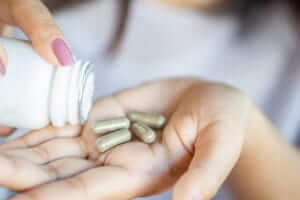What is Endometriosis?
The lining of the inside of the uterus is called the endometrium. Women with endometriosis experience the growth of this endometrial tissue in places outside of the uterus itself, most commonly elsewhere in the abdomen–ovaries, intestines, fallopian tubes, or the peritoneal cavity (1).
No matter where in the body it’s located, endometrial tissue responds to the same hormones that it does when it’s on the inside of your uterus–meaning it bleeds and responds to changes in our menstrual cycle (1).
This bleeding outside the uterus causes inflammation, and a whole lot of pain, and scar tissue. Your body has developed mechanisms to protect itself from this inflammation by forming what are called adhesions, although these adhesions can cause problems of their own when they impact normal ovarian function, or digestion, depending on where they’re located.
Another compounding factor is that endometrial tissue located outside the uterus tends to be more fibrous and prone to developing cysts.
How is Endometriosis Diagnosed?
There are no lab tests that can detect endometriosis, and CT scans or ultrasounds can provide suspicion for endometriosis, but they can’t confirm it.
An official diagnosis of endometriosis requires surgery and biopsy. This might be one reason it takes women, on average, 8 years after the onset of symptoms to receive the right treatment or diagnosis (2). Doctors typically do not choose to operate on a woman presenting with pain, so symptom management is often the next choice.

Recently, a blood test called the Mitomic Endometriosis Test has become available that claims to detect about 90% of endometriosis cases (3). This could be a promising method of early detection for endometriosis soon.
Many women suffer for years and are misdiagnosed multiple times, resulting in unnecessary or ineffective treatment options. This leaves many women dependent on hormonal birth control to manage symptoms, and OTC painkillers like ibuprofen, or tylenol–which are largely ineffective and aren’t without their own potential side effects, especially with high dosage, long-term use (4).
So how do we determine if endometriosis is the culprit of our difficult periods without going underneath the knife? Don’t fret just yet, there’s a collection of signs and symptoms you can look for that provide a little more insight.
Signs and symptoms
Heavy or Long Periods
Two-thirds of women with endometriosis report heavy menstrual flow, and sometimes need to wear a pad AND tampon or menstrual cup combined (5).
Painful periods
This isn’t the kind of pain that can be alleviated with ibuprofen. Endo pain is often debilitating and will have you (at best) in the fetal position or (at worst) vomiting.
Pain during sex, bowel movements, or urination
Adhesions, or scar tissue from endometriosis, can form anywhere in the abdomen. And depending on where adhesions are located, they can cause significant pain while performing normal daily activities.
Fatigue
Energy levels are dependent on lots of factors, but major components are hormone balance and inflammation levels.
Infertility
Endometriosis can damage the ovaries, block fallopian tubes, and generally cause difficulty getting pregnant.
Nausea or vomiting
Severe pain for several days per month can sometimes lead to upset stomach, decreased appetite, or actual vomiting.
Just a lot of Pain
If you haven’t noticed this trend by now, one of the biggest causes for endometriosis suspicion is pain, pain, and pain (5).
Integrative Medicine for Hormone Health
The difference in treatment modalities between conventional medicine and an integrative approach will make a significant impact in improving whole-body hormone function. Integrative practitioners will work with you to create optimal wellness and balance hormones in a way that will address the functioning of your entire body–rather than merely treating symptoms.
Endometriosis is a complex condition involving gut health, liver function, hormone balance, and autoimmunity. Integrative physicians will work to address all of these aspects to see improvement in quality of life, fertility, and hormone health.
Schedule your virtual consult today to get started with your personalized treatment plan.
What Causes Endometriosis?
We don’t yet have a definitive cause for endometriosis, but we do know it has a probable link to a few other chronic conditions. Certain diet and lifestyle factors can exacerbate symptoms, so it’s most effective to take a look at the suspected root causes.
Environmental Toxins
Toxins in the environment that function as endocrine disruptors can not only alter the messages hormones normally send, but they can also negatively impact detox processes and liver function.
If the body’s detox pathways can’t properly metabolize hormones, these excess messengers can contribute to what’s called estrogen dominance, which we know plays a role in endometriosis.
What Do Detox, Liver Health, and Hormones Have in Common?
One thing we know is that endometriosis is affected by estrogen levels (6). And estrogen levels are affected by liver function and the body’s ability to effectively detox.
Support detoxification of excess hormones in the liver and increase antioxidant production with N-acetyl cysteine.
If the body can’t properly metabolize excess estrogen, this is one factor for estrogen dominance. Estrogen can overstimulate endometrial tissue anywhere in the body to proliferate, so getting estrogen back into balance has a major influence on endometriosis.
Autoimmune & Endometriosis Link
Doctors and researchers are still working to understand all the facets of endometriosis, but we do know that it’s an inflammatory condition, with a probable link to autoimmunity, and intestinal permeability, or leaky gut. There’s a hormonal component as well, and a family history can make it more likely.
In some cases of endometriosis, researchers have identified certain antibodies that indicate endometriosis has an autoimmune component (7).
Endometriosis and Leaky Gut
Leaky gut, or intestinal hyperpermeability, is a condition in which undigested proteins, bacteria, and other unwanted substances are allowed to leave the intestine through larger than normal gaps in our intestinal lining.
Once outside our gut, these substances trigger an immune response, and can alter immune function in the long-term, with the body creating antibodies against our own tissue.
Stress, infections, food sensitivities, drugs (NSAIDS and hormonal birth control), and antibiotics can all cause inflammation within the intestinal lining, contributing to leaky gut. And all of these things can affect detox pathways, and hormone function.
Healing Endometriosis Naturally
You might be among the tens of thousands of women who have had conversations with their doctor about the best treatment for endometriosis. You may have been told that symptom management with painkillers or birth control is the best plan, and in some cases surgery is an option as well.
While we don’t want to minimize the acute treatment methods offered by your doctor, hormonal birth control doesn’t have to be the ONLY option for treatment. Birth control can help manage some of the pain, and sometimes, getting a woman OUT of pain will give her a chance to implement holistic solutions she needs to make progress with her endometriosis.
A woman in severe pain 10 or more days per month will most likely not have the capability to do things like eat well, exercise, and incorporate other healthy lifestyle changes.
7 Steps to Heal Endometriosis
-
Heal your gut
While cleaning up your diet is absolutely an important part of the puzzle, dietary changes alone are often not sufficient to see significant improvement. Fixing your gut is essential, but don’t be hard on yourself if you aren’t able to make dietary changes consistently. I’ve developed my Belly Fix course to provide guidance for eliminating inflammatory triggers, detoxing, and balancing hormones.
-
Manage stress
Developing good stress management supports the adrenal glands, which produce cortisol that lowers inflammation. Cortisol gets a bad reputation, but a healthy stress response is due, in large part, to cortisol communicating with receptors in the body. Chronic stress alters this response and dysregulates cortisol.
-
Sleep
Studies have shown that melatonin can reduce PMS pain, painful urination, and pain during bowel movements (8). Support melatonin production by wearing blue blockers at the computer, turning off devices two hours before bedtime, and sticking to a relaxing nighttime routine.
Sleep Savior includes B6 which naturally supports melatonin production, and magnesium, which is essential in the process of converting tryptophan into melatonin. Magnesium also helps modulate prostaglandin production, which are the hormones that cause cramps.
-
Decrease inflammation
Removing gluten, dairy, and soy is beneficial for many struggling with endometriosis, but it’s likely you have food sensitivities or intolerances that contribute to chronic inflammation. You can test for food intolerances with your integrative practitioner at CentreSpringMD.
Following an elimination diet temporarily can help you identify inflammatory reactions you may be having to certain foods.
In addition, incorporating inflammation modulating supplements is a tremendous help with endo symptoms and pain.
- Omega 3 – Prostaglandins (the messengers that send the pain response during cramps) can be made from omega 3 fats, or omega 6 fats. Prostaglandins themselves aren’t bad things, but the kind of fat they’re made from affects how
 much inflammation or pain they cause in the process of doing their job.
much inflammation or pain they cause in the process of doing their job.
- Turmeric – Curcumin, the component in turmeric is a well studied compound for inflammation support. Turmeric has been used in Ayurveda for centuries, and displays benefits for liver support, digestion, and inflammation.
- EGCG or resveratrol – a potent antioxidant, these polyphenols showed improvement in the size and number of adhesions caused by endometriosis (9)
-
Support hormone balance
We know that endometrial tissue is sensitive to hormones. So supporting estrogen metabolism and hormone balance is an important factor.
Hormone helper promotes healthy hormone balance, energy, and thyroid function. DIM, found in cruciferous vegetables, supports healthy levels of estrogen, and aids in the metabolism of excess estrogen.
-
Develop mental/emotional support
Women who experience chronic pain, like which we have with endo, are more likely to suffer from depression and anxiety as well. It’s important you address your mental health and ability to cope with what can be a debilitating condition. It’s a difficult journey, and asking for help is something kind you can do for yourself.
-
Begin a conversation with your doctor
Some women with endometriosis need to have surgery to remove adhesions–and that’s ok. Whether you do or don’t think surgery may someday be an option for you, it’s still a good idea to develop a relationship with your doctor to discuss options for surgery should it become an option. Best to have t
hat information in your wheelhouse as a backup!
Be Your Own Advocate
Navigating endometriosis treatment can be confusing, exhausting, and painful, but you are not alone in this.
You are the only person who lives in your body, and I urge you to be an advocate for yourself when you feel something isn’t normal. There is natural help for managing endometriosis, but it takes you putting yourself first for a while in order to live your life with reduced pain.
How are you managing endometriosis? Have you had success with birth control or do you choose the more natural route?
Share this important information with a woman in your life who needs it!
Resources
- https://www.uptodate.com/contents/endometriosis-pathogenesis-clinical-features-and-diagnosis/abstract/1
- https://www.endonews.com/how-long-does-it-take-to-be-diagnosed-with-endometriosis
- https://mdnalifesciences.com/2019/04/worlds-first-blood-test-for-endometriosis-can-detect-up-to-9-out-of-10-cases/
- https://www.ncbi.nlm.nih.gov/pubmed/25165691
- https://www.fertstert.org/article/S0015-0282(07)00791-1/fulltext
- https://www.nature.com/articles/nrendo.2013.255
- https://www.ncbi.nlm.nih.gov/pubmed/22330229
- https://www.ncbi.nlm.nih.gov/pubmed/27048013
- https://www.ncbi.nlm.nih.gov/pubmed/23081870

